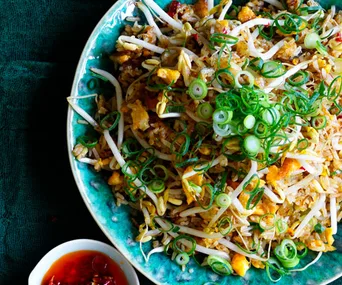Some Chinese gourmands call it the emperor of sauces, others the king. Chefs and restaurateurs jealously guard its recipe, and top-drawer Chinese restaurants proudly offer this classy condiment to their valued clients. XO sauce, to the ever-food-conscious Chinese, raises much comment in any Chinese restaurant worth its salt. Considering it’s consumed mostly as a condiment, dip or appetiser, and can cost some hundreds of dollars to prepare, this must be one of the most luxurious food indulgences in the world. It stands head and shoulders above the rest of Chinese sauces not only because of its expense but also because it represents the continued evolution of Chinese cuisine, based on a very sound knowledge of ingredients.
So what is XO sauce? Named after XO Cognac to symbolise wealth, status and exclusivity, this savoury, glossy relish is made essentially from fresh and dried chillies, shallots, garlic, top-quality dried scallops (conpoy), dried shrimps and Yunnan or Jinhua ham; these last three ingredients are especially appreciated for their intensity and complex flavour.
Dried scallops, depending on their quality, can cost up to $300 per kilogram. When buying, ask for the stash held behind the counter at Chinese grocers – that’s where you’ll find all the good stuff. Yunnan and Jinhua ham are also costly – they’re akin to jamón and prosciutto, and these are good substitutes as Chinese ham is difficult to find in Australia.
These ingredients, along with shallots, ginger and garlic, are cooked over medium heat for up to an hour and a half, resulting in a multi-layered and robust paste with an intriguing nose. The diner first tastes the chilli, then the amalgam of seafood, before the ham takes over, releasing intense, complex and glorious flavours that burst in the mouth. It’s extremely moreish, spicy, salty and sweet; if you’re a chilli-lover, you’ll find it near impossible to say no to XO sauce.
XO’s culinary history, although relatively short, is shrouded in secrecy and mystery. The general consensus seems to be that it first appeared in the early ’80s, somewhere in the top-end seafood restaurants of Hong Kong. Spring Moon, the Chinese restaurant at The Peninsula, is often credited with its invention, while others believe the seafood restaurants in Kowloon’s Tsim Sha Tsui district are more likely to have been reponsible for its creation.
Irrespective of its birthplace, there’s no denying this rich sauce’s ability to add that extra something special to many a dish. It’s delicious with prawn dumplings such as har gau, or a plate of stir-fried scallops, or braised Cantonese egg noodles (yi meen) with prawns, or as a topping on beancurd. It’s also excellent tossed through steamed mussels as we have done here. Although it’s possible to buy XO in a jar, it really doesn’t compare. As labour-intensive – and expensive – as it is, you won’t fail to be impressed by this king of sauces.
Ingredients
Method
This recipe makes about 500gm. You’ll need to begin this recipe a day ahead.
To roast shrimp paste, wrap in aluminium foil and roast at 200C until fragrant (4-5 minutes).
Dried shrimp roe is available from Asian grocers.
Notes
 Ben Dearnley
Ben Dearnley

